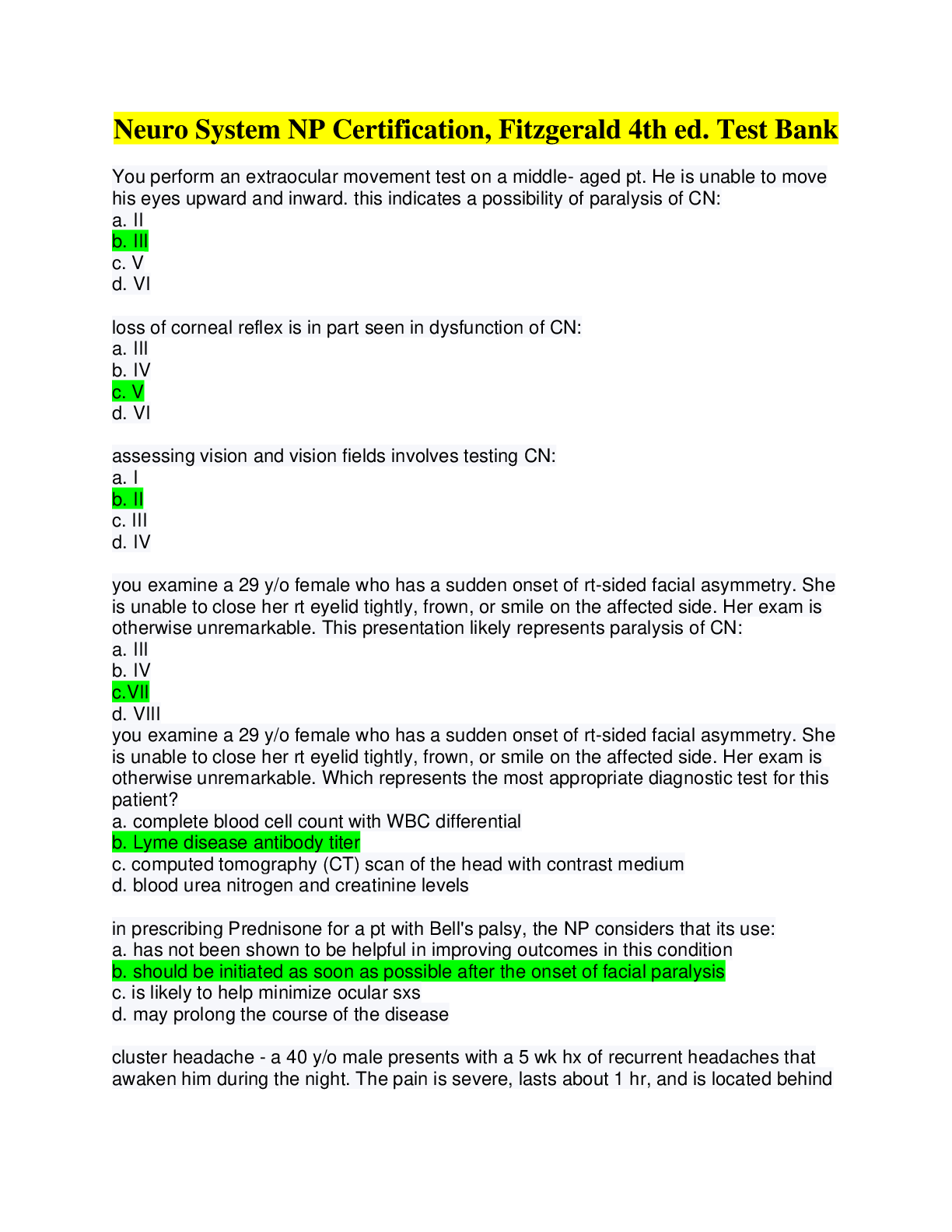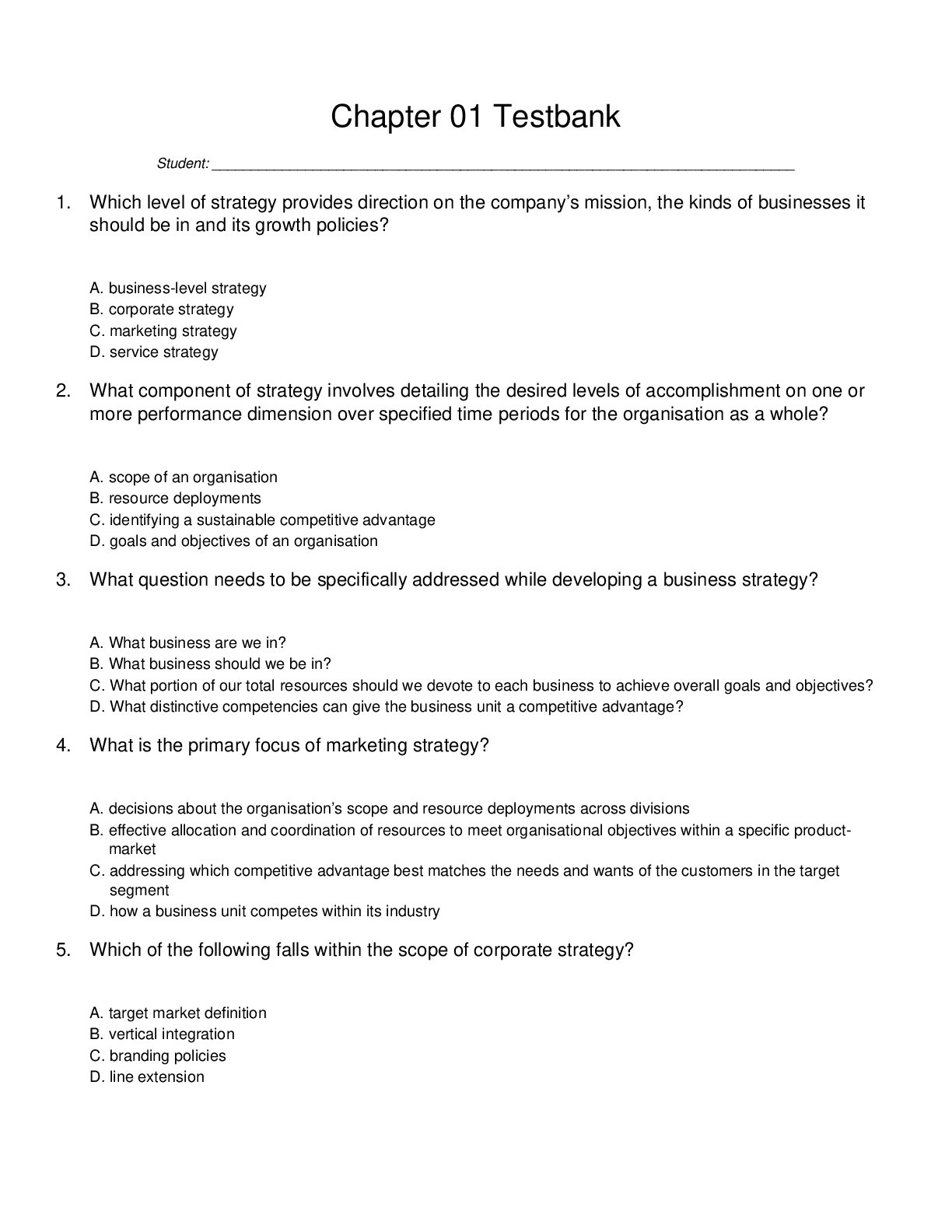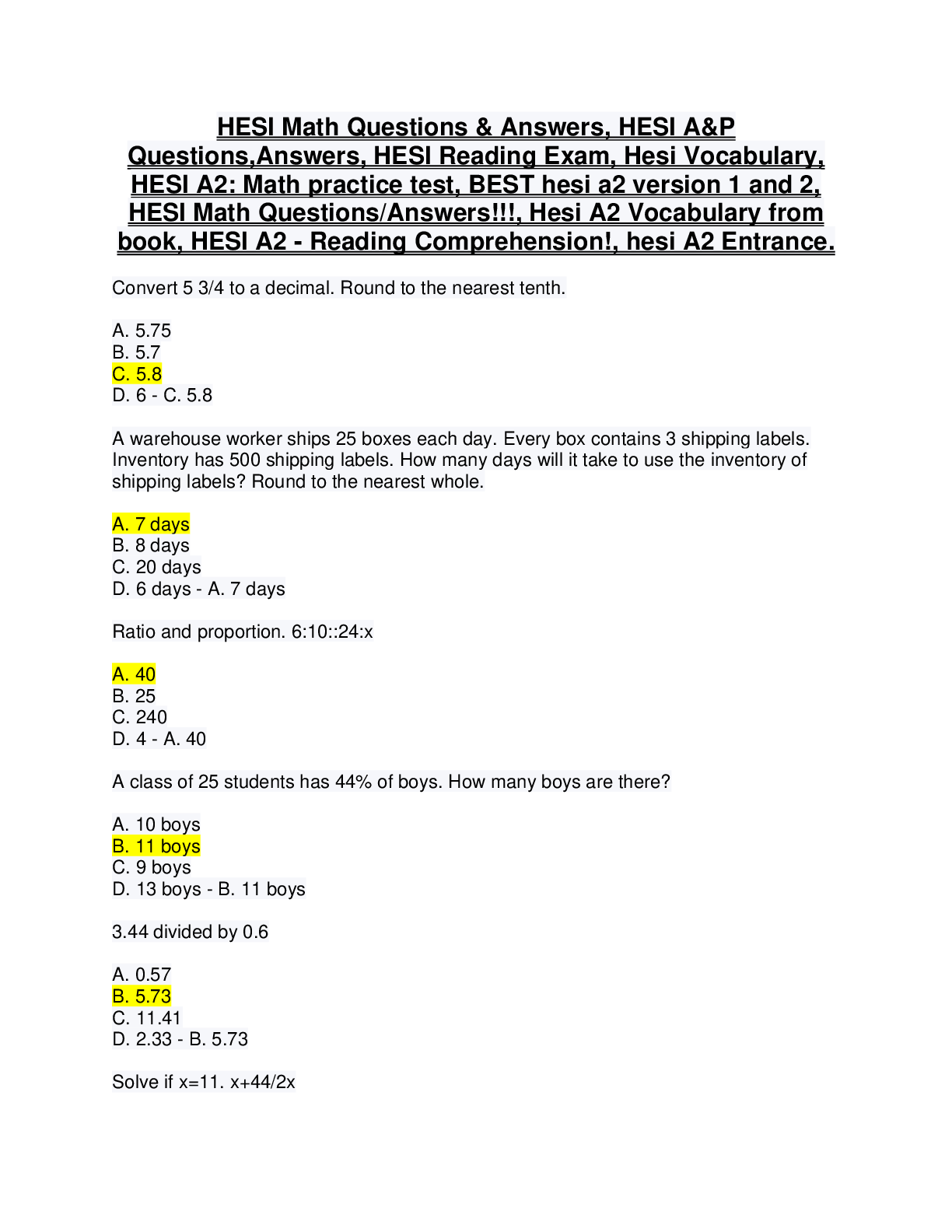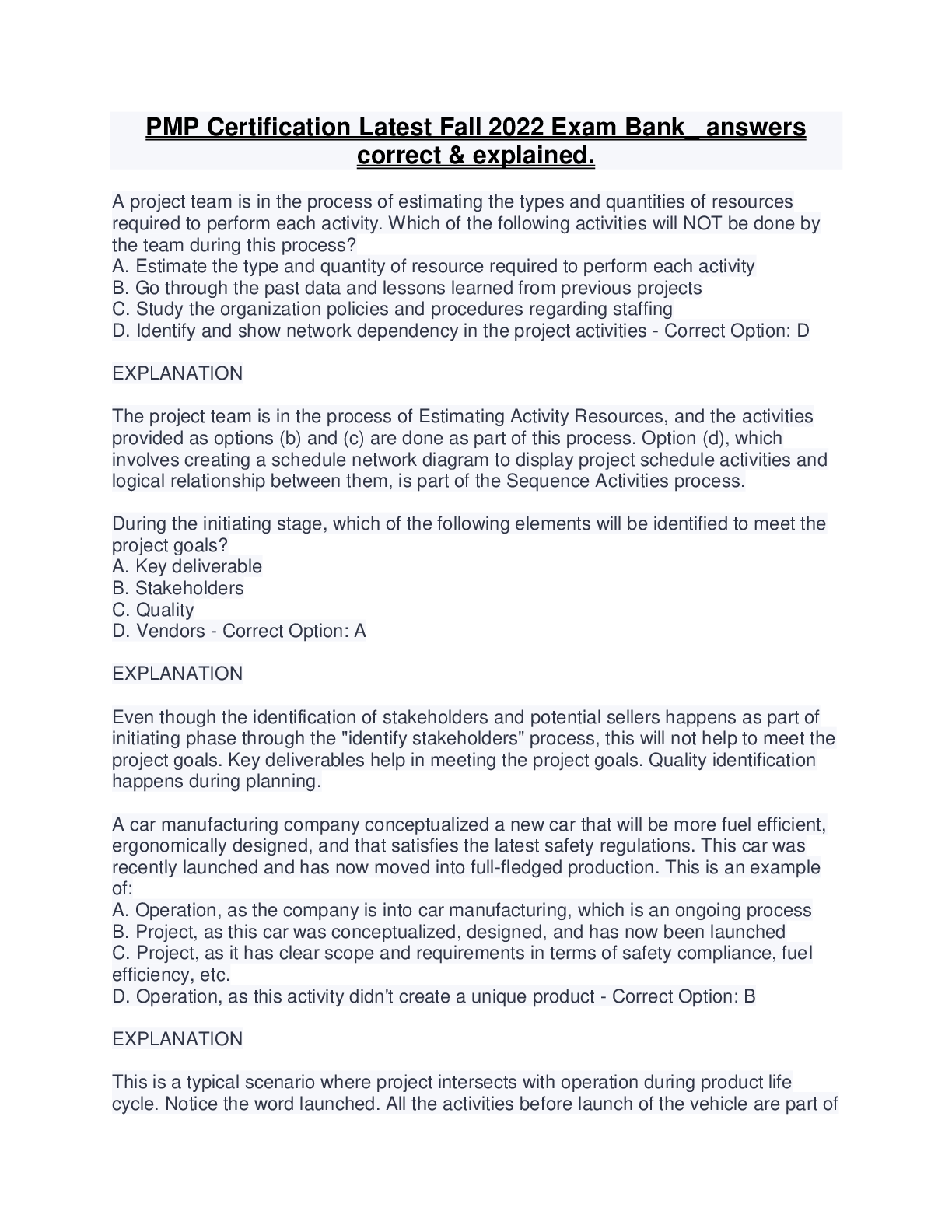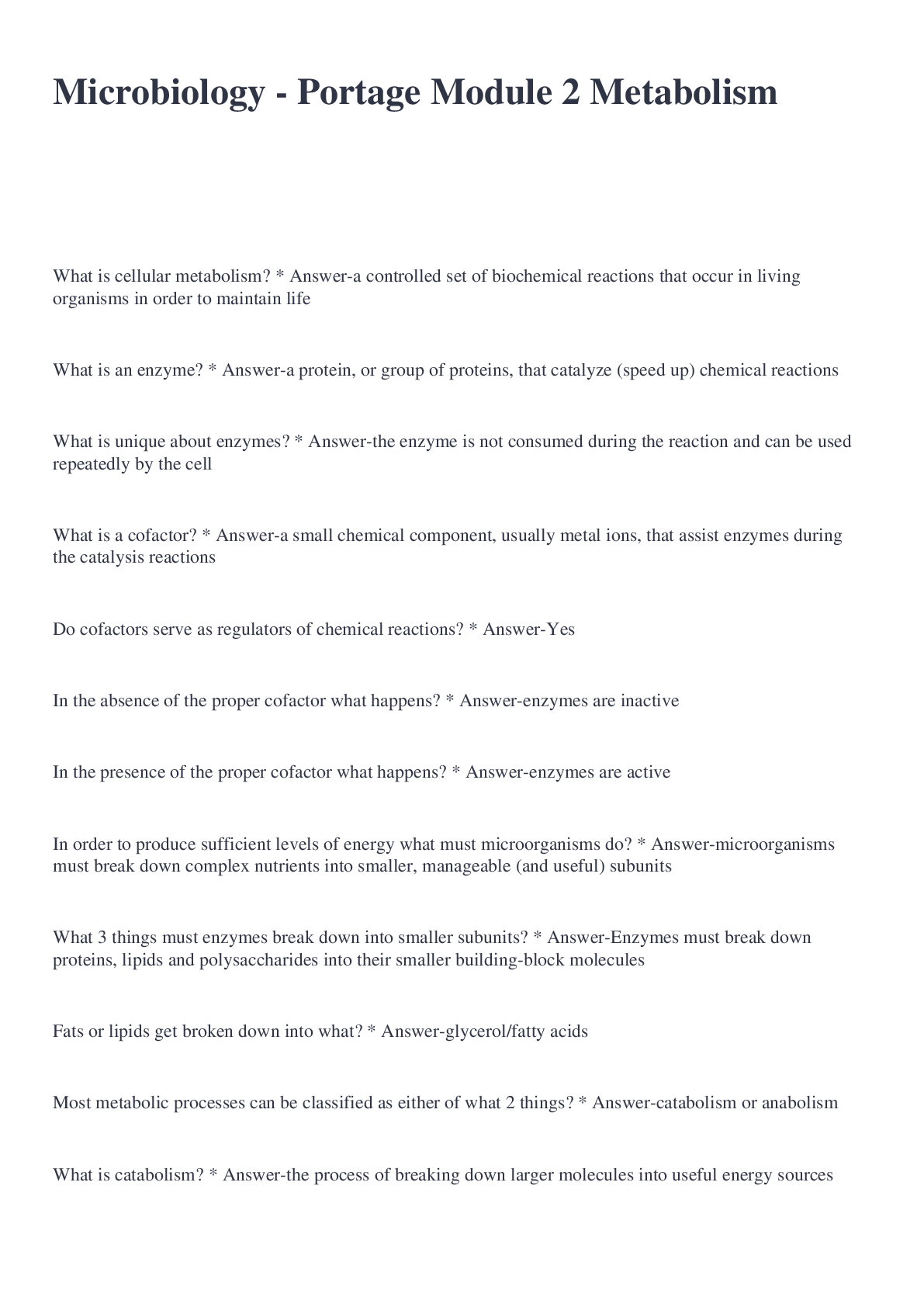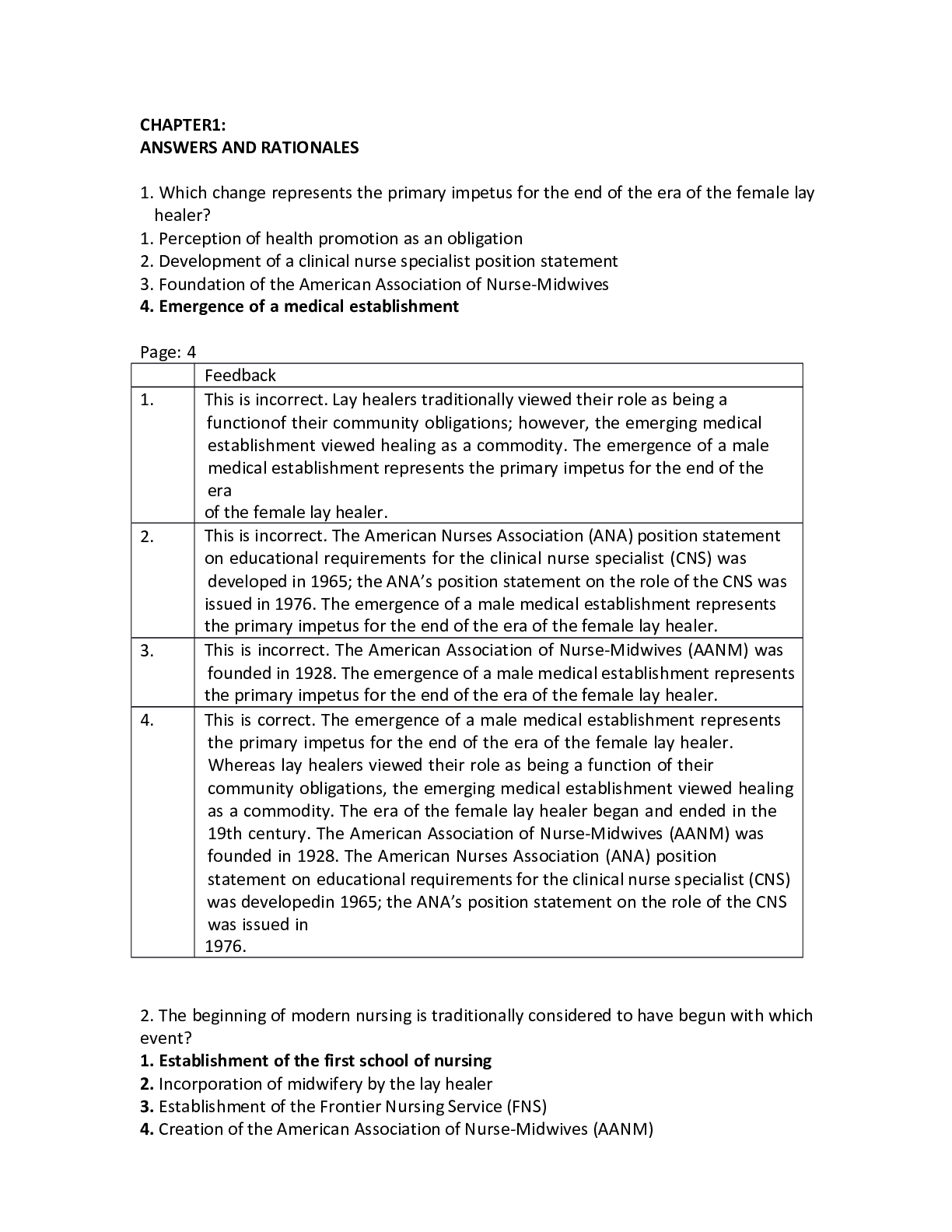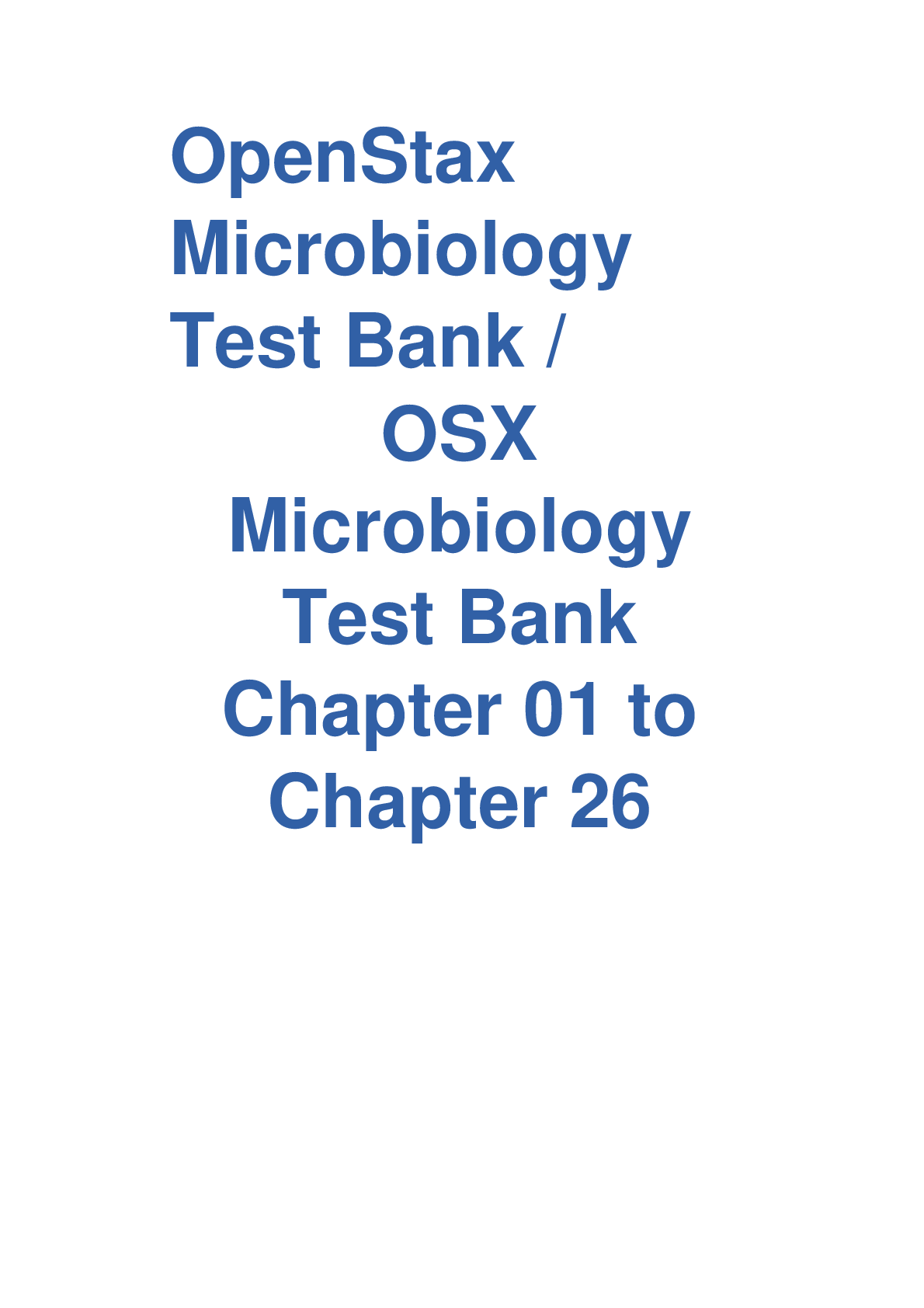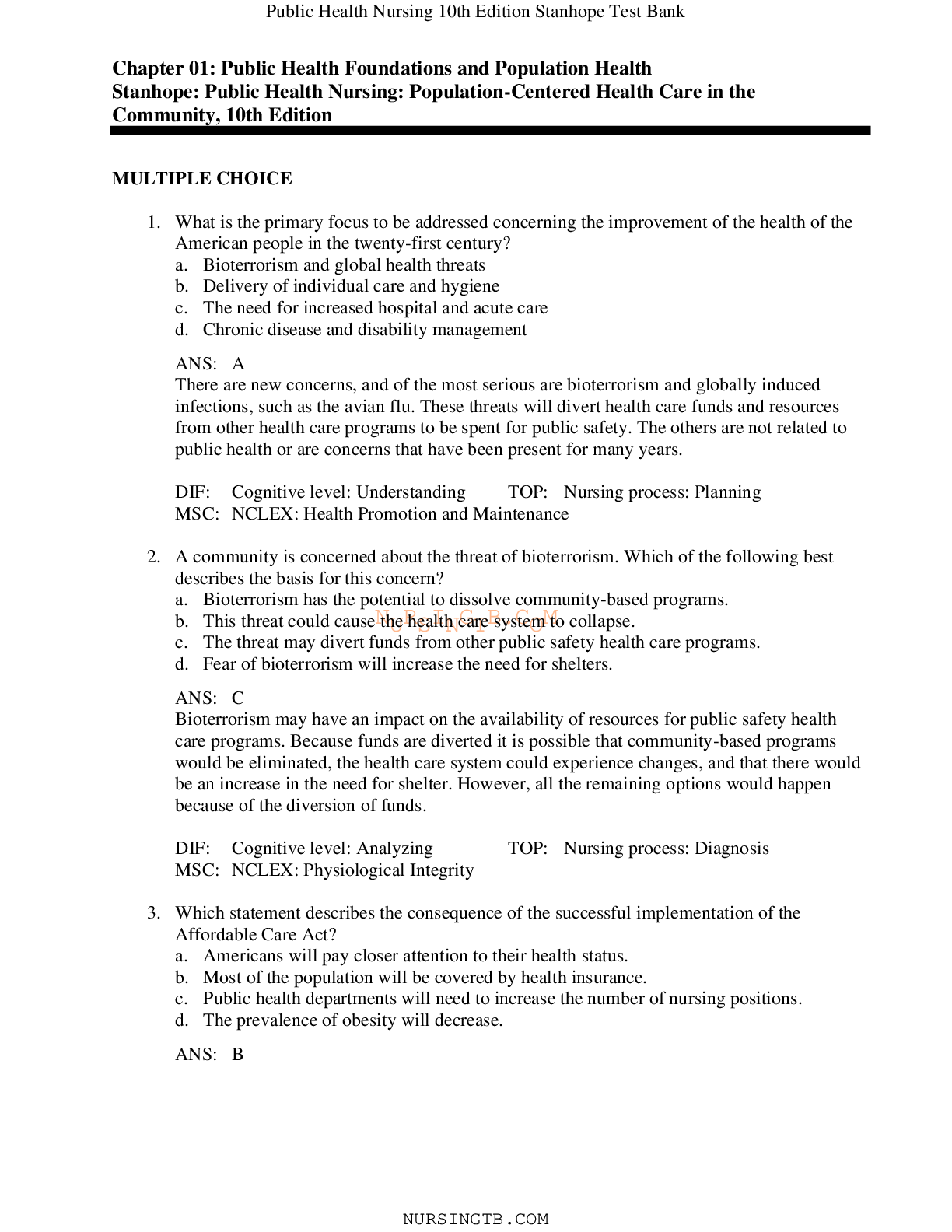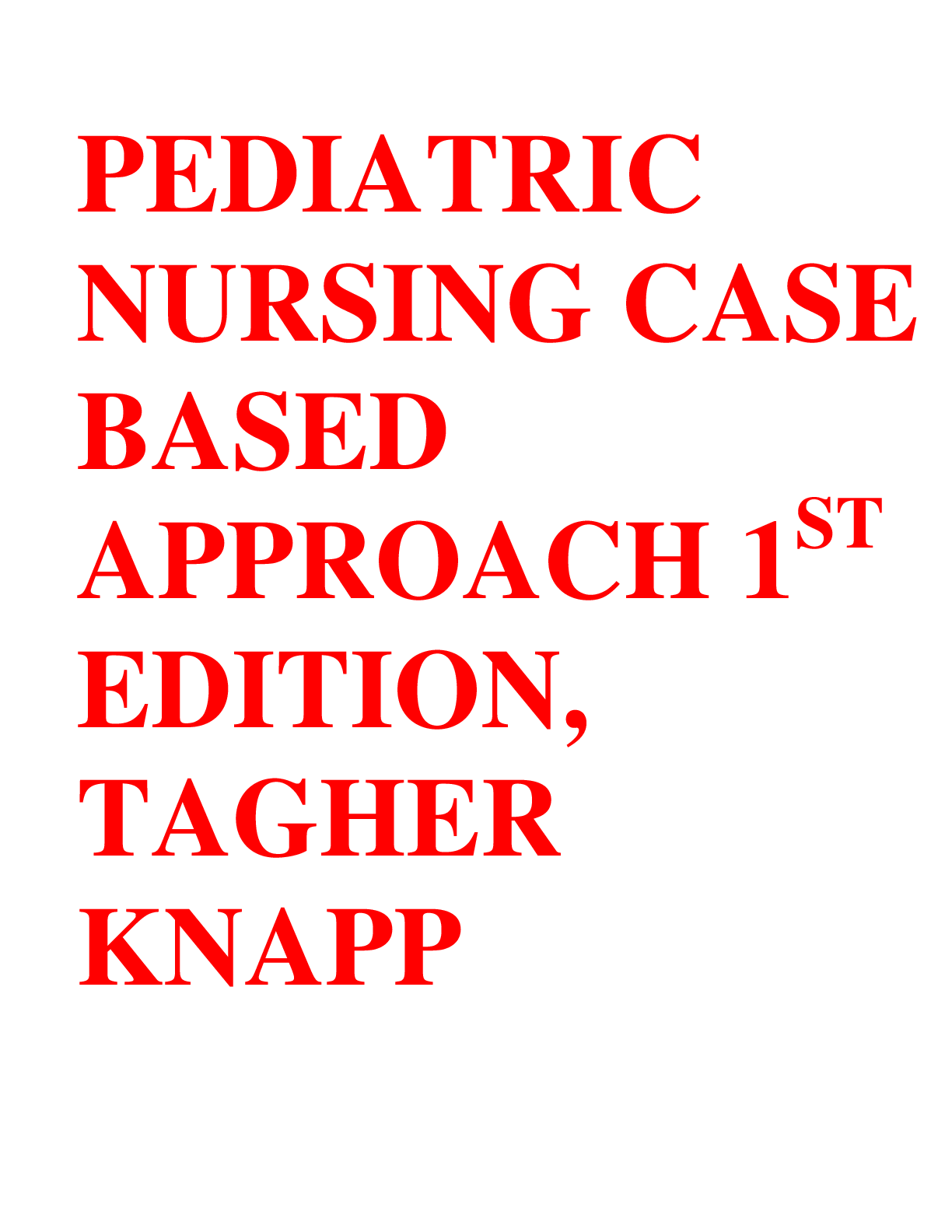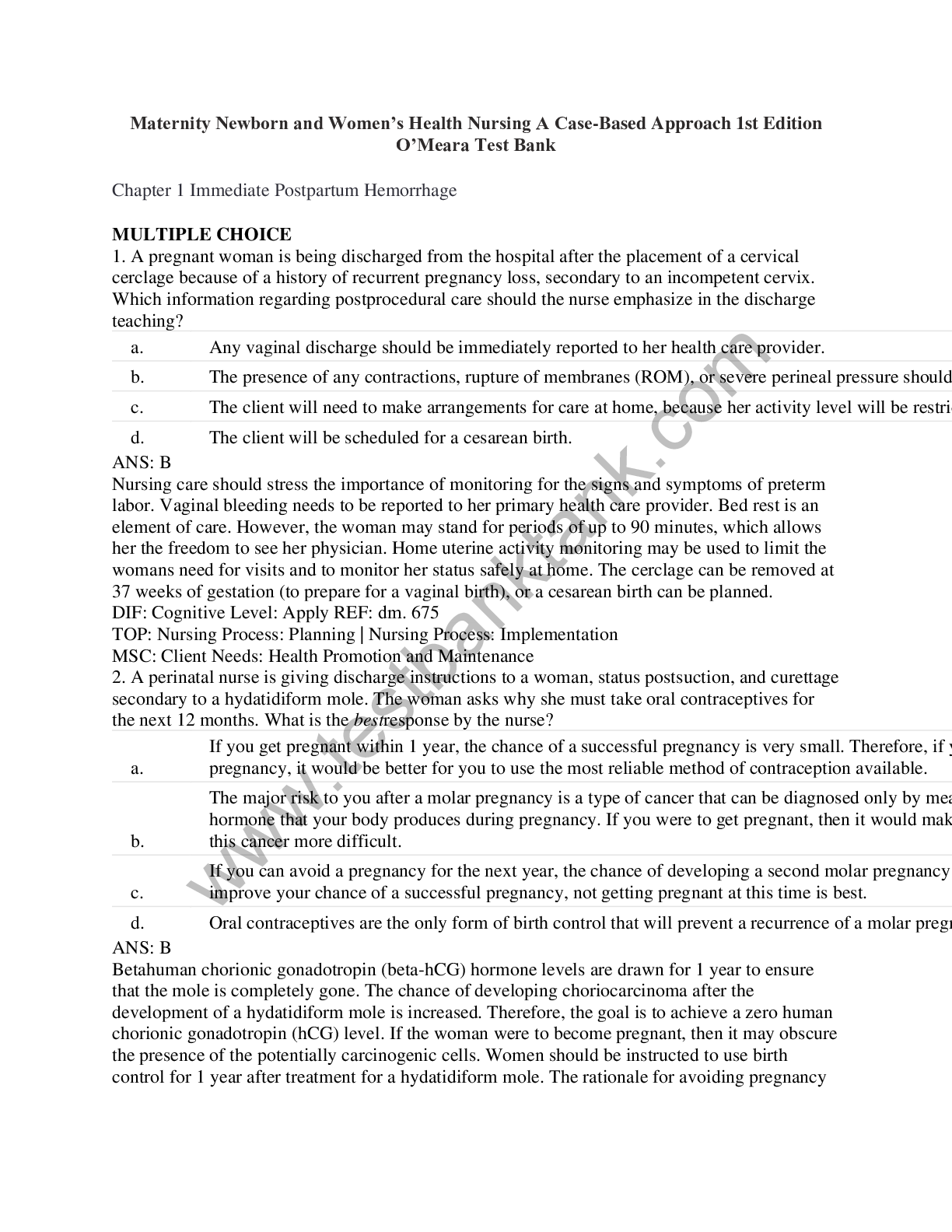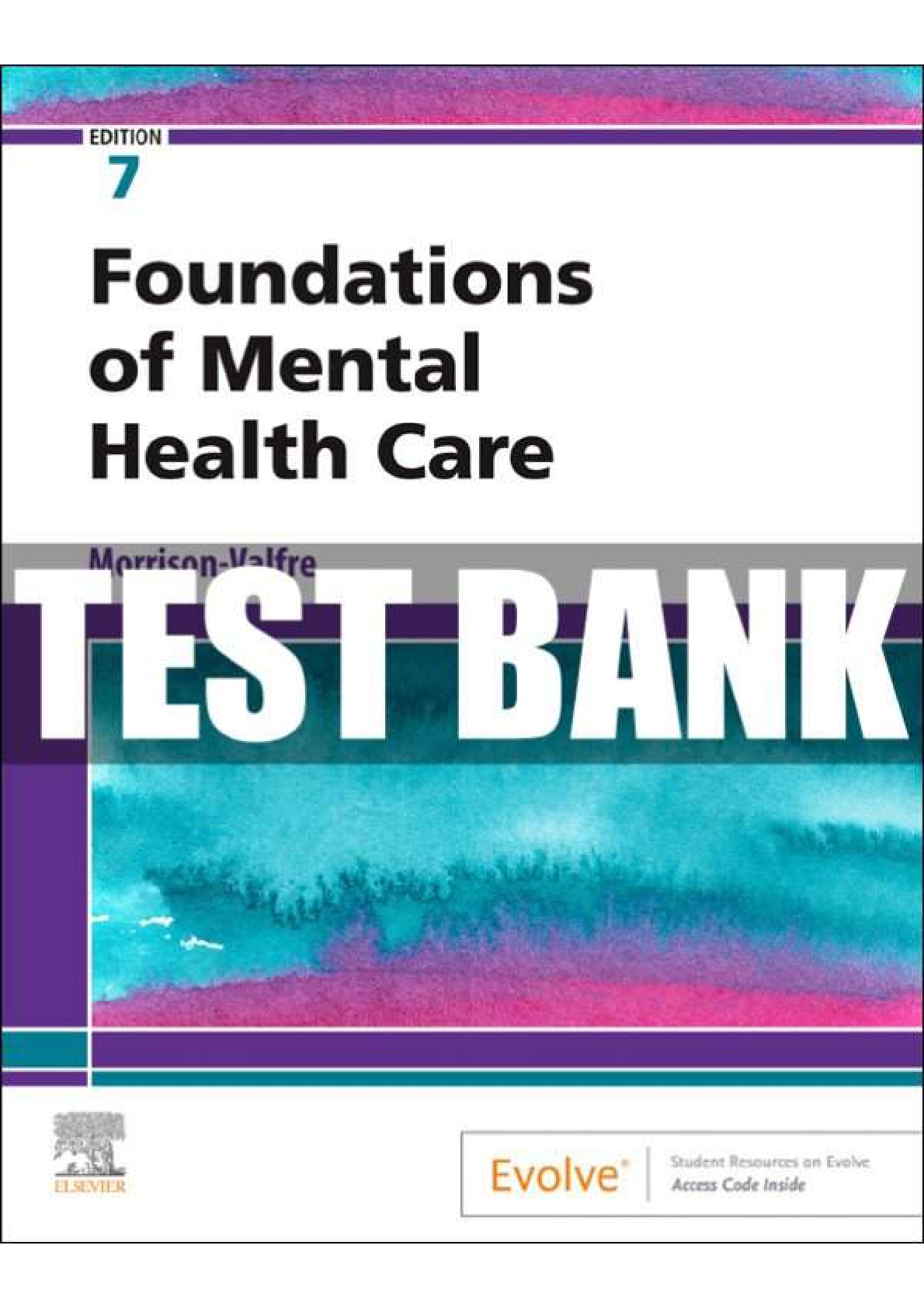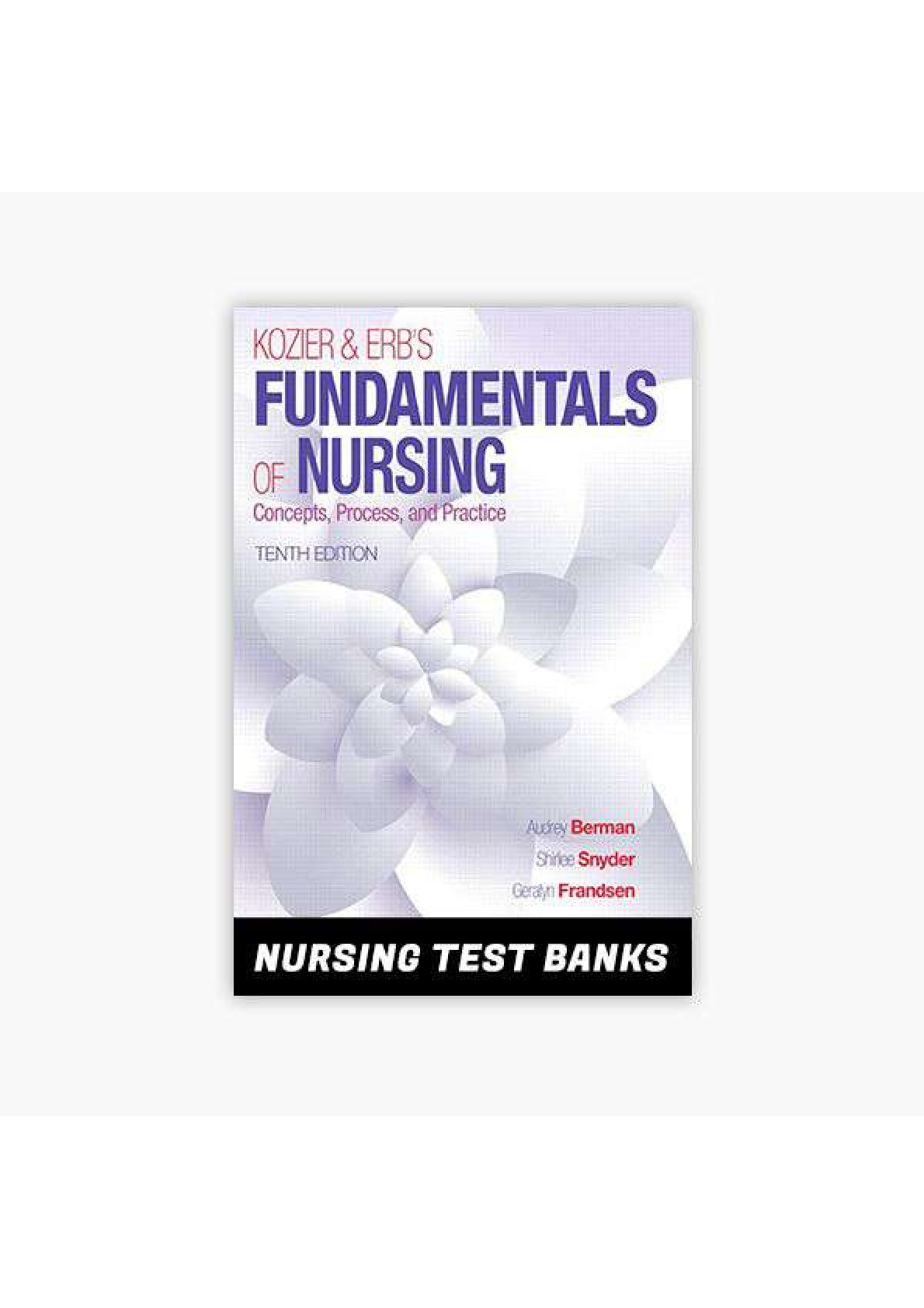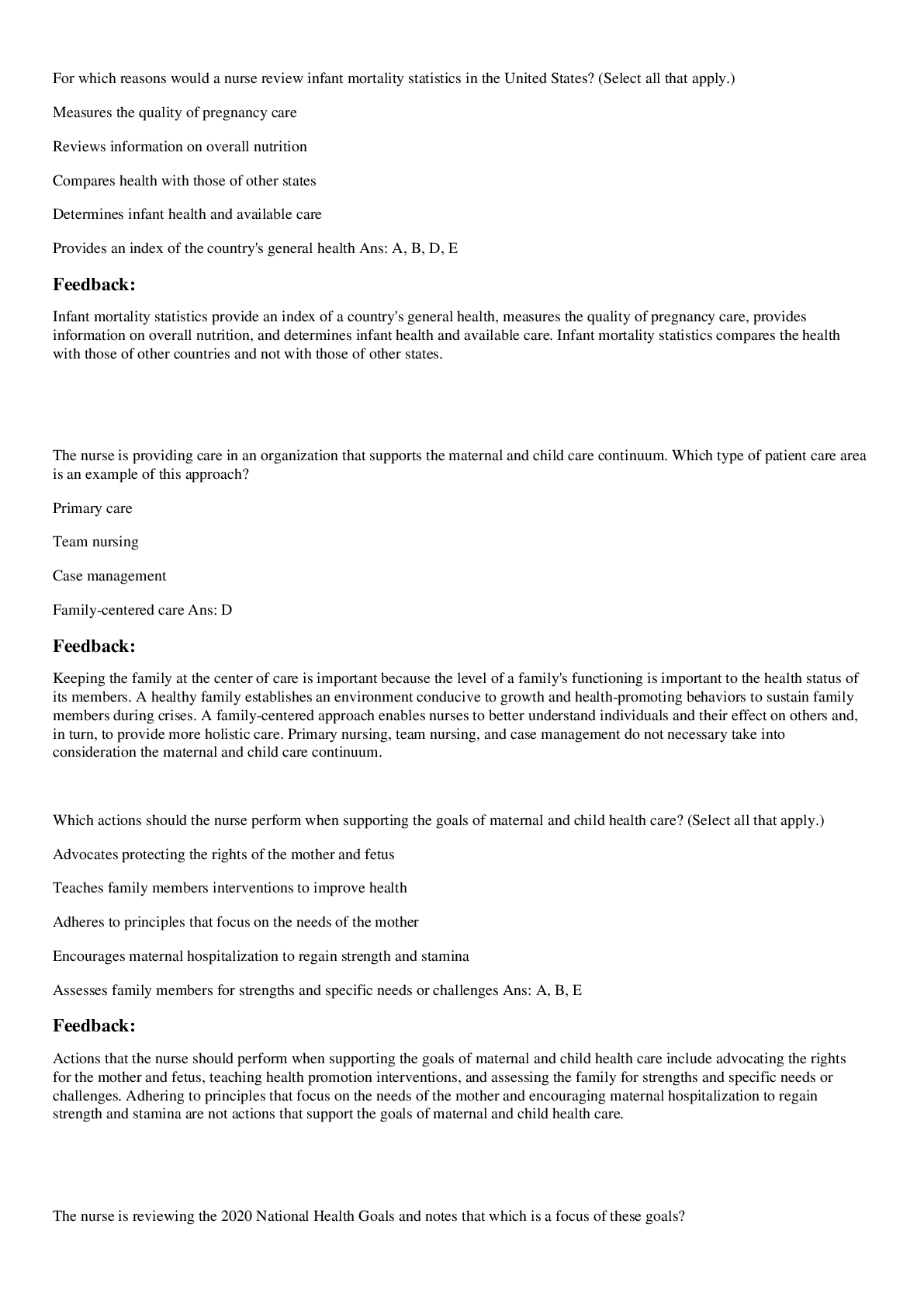*NURSING > TEST BANK > NCLEX LIVE-REVIEW QUESTIONS POR TEMAS / NCLEX LIVE-REVIEW TEST BANK / ATI NCLEX LIVE-REVIEW - Guaran (All)
NCLEX LIVE-REVIEW QUESTIONS POR TEMAS / NCLEX LIVE-REVIEW TEST BANK / ATI NCLEX LIVE-REVIEW - Guaranteed A+ guide.
Document Content and Description Below
NCLEX LIVE-REVIEW QUESTIONS POR TEMAS Introduction to NCLEX Questions 1- A nurse admits a client who sustained C3 spinal cord injury. Which finding should the nurse recognize as priority of care? ... a) Heart rate b) Respirations 10/min c) Temperature 97 F (36 C) d) Blood pressure 88/54 mmHg 2- A nurse prepares an older adult for a scheduled colonoscopy. Which should be the nurse’s initial action? a) Chill bowel cleansing solution b) Monitor frequency of elimination c) Provide oral intake of clear liquids d) Place portable commode at bedside. 3- A client presents to the emergency department (ED) and reports a history of Gravida 3 Para 2. Which should be the nurse’s initial action after observing a presenting part? A) Provide emotional support to the client B) Notify labor and delivery staff members. C) Time frequency and duration of contractions D) Prepare for delivery of the newborn in the emergency department 4- A nurse enters the room of a client who is at the foot of the bed lying on the floor. Which should be the initial nursing action? a) Examine the client’s injuries. b) Obtain pulse and blood pressure c) Assess vital signs and level of consciousness d) Determine intensity of pain with range of motion. 5- Four days after a ventral hernia repair, a client who is obese and has history of COPD vomits and reports severe abdominal pain. The oxygen saturation is 90%. Which action should the nurse implement first? a) Administer ondansetron hcl IV. b) Encourage pursed lip breathing c) Assess the surgical incision site d) Apply low dose oxygen via nasal canula6- A nurse provides care for a client who is 24 hors post-acute myocardial infarction and reports “I can’t breathe now that I am lying down after lunch”. Which should be the nurse’s initial action? a) Administer IV furosemide b) Place client in high-fowler’s position c) Begin oxygen 4-6L/min by nasal cannula d) Auscultate anterior and posterior lungs bilaterally 7- A nurse arrives at a work site explosion. Which client should the nurse triage first? a) Fixed pupils and agonal respirations b) Burns to the face and respiratory stridor c) Type 2 diabetes mellitus who is disoriented d) A closed fracture reporting “a pain level of 3” 8- A nurse is coordinating client care. Which client should the nurse delegate to the PN? A client who: a) Requires insertion of an indwelling urinary catheter. b) Has a new prescription for patient-controlled analgesia c) Has a tension pneumothorax and requires a chest tube? d) Requires intermittent suctioning of a new placed tracheostomy. 9- An adolescent client was admitted 12 hrs ago following a motor vehicle crash. Multiple skeletal fractures were sustained. The client is in balanced-suspension traction. Which assessment finding requires immediate intervention by the nurse? a) Disorientation b) Shallow respirations c) Chest pain with positioning d) Bloody drainage at the pin site. 10- A nurse provides care for a client who is scheduled for electroconvulsive therapy (ECT). Which medication should the nurse withhold prior to therapy? a) Atropine sulfate b) Phenytoin c) Methohexital d) Succinylcholine 11- A home health nurse is performing an admission assessment on a client who had a knee arthroplasty one week ago. Which client statements should concern the nurse the most? a) “I am so glad to be off those blood thinners” b) “I will keep a pillow under my knee when I am in bed “ c) “I am planning to use a wheelchair to help me get around”d) “I plan to take ibuprofen instead of the prescribed hydrocodone with acetaminophen for pain control” 12- A client has no voided eight hours following the removal of an indwelling bladder catheter. Which should be the nurse’s initial action? a) increase fluids b) perform bladder scan c) place indwelling catheter d) provide assistance to the bathroom 13- A nurse provides care for a client who has a chest tube. The nurse notes the chest tube has become disconnected from the chest drainage system. Which action should the nurse take? a) Increase the suction to the chest drainage system. b) Reposition the client to a high-fowler’s position c) Apply to the client low-flow oxygen via nasal cannula. d) Immerse the end of the chest tube in a bottler of sterile water 14- When an older adult die from complications of a cerebrovascular accident (CVA), the client ‘s partner is present the bedside. Which action should the nurse take? a) Give the partner time alone b) Stay with the partner at the bedside c) Ask the chaplain to come be with the partner d) Escort the partner to the hallway outside the room 15- A client who has just been diagnoses with rheumatoid arthritis is required to receive 3 months of methotrexate therapy. The nurse recognizes which of the following are adverse effects associated with the therapy? SATA a) WBC 1,200 mm3 b) Platelets 5,000 mm3 c) Weight gain 2.27 kg (5lb) d) Urine specific gravity 1,003 e) Oral temperature of 37.2 C (99 F) 16- A nurse is organizing care for a group of clients. Which task should the nurse assign to the assistive personnel (AP) a) Record a client’s vital signs during a transfusion of blood b) Assist a client who is requesting a bedpan 1-day post hysterectomy c) Offer a pamphlet regarding advance directives to a newly admitted client d) Ask a client if pain was relieved after administration of acetaminophen 17- A nurse is observing a client attempt three-point crutch walking. Which action should be of concern to the nurse? a) The client kip arms flexed b) The client moves legs with opposite armc) The client backs up to a chair before sitting d) The client asks for a height adjustment of the crutches. 18- A school nurse observes several children playing on a playground. Which child should concern the nurse most? a) A child squatting after a game of ball b) A child arguing with another child c) A child breathing heavily after running d) A child climbing on swing set supports 19- A client who is semi-comatose after a cerebrovascular accident (CVA), has an NG tube, and was started on total parenteral nutrition today. Which action should the nurse implement to prevent fluid volume deficit? a) Administer 120 ml bolus of water b) Monitor blood glucose every 4-6 hr c) Determine total fluid intake every 8 hr d) Increase oral fluid intake to 3 liters per day LEADERSHIP AND MANAGEMENT INTRODUCTION 1- A nurse prepares a staff in-service on incident reports. Which information should the nurse include? SATA a) risk management investigates the incident b) a copy of report is placed in client’s health record. c) reports include description of incident and actions taken. d) reports are confidential and not shared with noninvolved staff. e) completion of report should be documented in the nurse’s notes 2- A nurse is unsure of the proper technique when caring for a client who is prescribed enteral feedings. Which action should the nurse take? a) Ask the charge nurse for step-by-step directions b) Call the provider for specific instructions c) Consult the unit procedure manual for guidance d) Delegate task to a PN to complete the feedings. 3- A nurse admits a client from a long-term care facility. Which action should be implemented? SATA a) Verify the admission medications prescribed by the provider b) Review the current medication regimen with the client c) Obtain the most recent list of medications from the long-term care facility d) Locate a list of discharge medications from the most recent hospitalization e) Discuss any discrepancies with the health care providerDELEGATION AND PRIORITATION1- A nurse cares for a client with terminal lung cancer. Which action should be delegated to the assistive personnel? SATA a) Encourage client to express feelings about the terminal diagnosis b) Assist the client to ambulate to the bedside chair twice a day c) Demonstrate to client the proper use of a bronchodilator inhaler d) Complete vital signs that include oxygen saturation every four hr e) Obtain a urine specimen from the client’s indwelling bladder catheter 2- A nurse cares for a group of clients on a medical-surgical unit. Which client should be delegated to the PN? SATA a) Newly diagnosed diabetes mellitus type II b) Facial lacerations and a subdural hematoma c) Bronchitis receiving bronchodilators treatments d) Exacerbation of myasthenia gravis admitted three hours ago e) Advanced regular diet two days postoperative cholecystectomy 3- A nurse assigns four clients to the PN. Which finding should the PN immediately report to the nurse? A client a) Receiving long-term IV antibiotics who has rash in his left groin b) With baseline regular apical pulse of 88 who has an irregular apical pulse of 120 today c) Who has a recent diagnosis of terminal cancer and refuses to eat or participate in hygiene care? d) Eight hours post laparoscopic surgery who reports abdominal and shoulder pain 4- A nurse plans to administer the following medications. Which medications should the nurse administer first? a) A scheduled IV antibiotic for a client with resolving pneumonia b) Pain medication to a client who rates their pain a 4-5 on 0-10 scale c) An antidiarrheal for a client with one diarrhea stool in the last hour d) An antipyretic to a client with a temperature of 100.7 F (38.2 C) 5- After receiving morning report on an adult medical unit, which client should the nurse plan to assess first? a) Client with acute glomerulonephritis with urine output of 160ml total on prior shift b) Client with bubbling in the suction control chamber of closed chest drainage systemc) Client three days postoperative for left mastectomy who is tearful and withdrawn d) Client with a wound infected with MRSA who wants to leave against medical advice 6- A nurse cares for a group of clients. Which should be the nurse’s initial action? a) Ask the AP to assist the transfer of a client to radiology for an echocardiogram b) Print a menu for family members of a client with newly diagnosed diabetes mellitus c) Notify the provider of a normal heart rate that changes to sinus tachycardia with a rate of 110 d) Request a repeat potassium serum level for an asymptomatic client with a prior level of 5.7 mEq/L ETHICAL AND LEGAL ISSUES 1- A nurse cares for a group of clients. Which information can be disclosed about a client? a) HIV status to the client’s coworkers b) Stage IV cancer diagnosis to the client’s family c) Uncontrolled seizure disorder to DMV d) Alcohol detoxification recovery status to client’s employer 2- A nurse notes the 16-year-old signed the consent form for a surgical procedure. Which action should be first? a) Cancel the surgical procedure until a valid consent form can be signed b) Verify the signature is witnessed appropriately and send the client for the surgery c) Determine whether the client meets legal requirements to sign the consent form (emancipated and completely independent; married; parent of a child (only to speak for the child) d) Locate the client’s parent or guardian to sign the consent form 3- A nurse administers a prescribed excessive dose of an IV gentamicin and the client experiences nephrotoxicity. Who would be accountable? SATA a) The FDA who approved use of medication b) The pharmacist who dispensed medication c) The company who designed the medication label d) The nurse who verified prescription of medication e) The health care provider who prescribed medication4- The RN hung an incurred bag of IV fluid. After noting the error, the infusion was corrected. The client’s IV site and VS were normal. Did negligence occur? No. There is a potential of harm, but no damage occurred. INFORMATION SYSTEM AND TECHNOLOGY1- A nurse prepares to document client assessment data to the unit’s computer system and has forgotten the login password. Which action should the nurse take? a) Ask to use a coworker’s password b) Let another nurse complete the data entry c) Request assistance from facility’s IT Department d) Document on paper to enter the computer at a later time COMMUNITY HEALTH NURSING1- A nurse provides phone triage with a client who was exposed to Ebola 1 week ago and denies symptoms. What is the best response by the nurse? a) “I will need to tell the Health Department” (because is very contagious. Principal symptom: hemorrhagic fever) b) “All household members should be vaccinated” c) “Since you are symptom-free, you were not infected” d) “A throat culture is an effective way to check for Ebola” 2- A nurse prepares a staff in-service on community Health. Which information identifies the role of the nurse? SATA a) Provides tertiary care to families b) Screens for giardia with county water authority c) Develops influenza vaccination program for refugee center d) Speaks to adolescents about the impact of alcohol consumption e) Focuses on media model to guide practice DISASTER PLANNING 1- A fire is forcing evacuation of clients from a nursing unit. Which client should be evacuated first? A client who isa) Admitted with pancreatitis with nasogastric tube and PCA device b) 48 hr hip replacement whose son and daughter are visiting c) Receiving IV antibiotics every 6 hr via saline lock for right leg ulceration d) Semi-comatose after a cerebrovascular accident with an indwelling urinary catheter 2- The emergency department (ED) nurse manager prepares for the arrival of numerous victims from an accident. Which should be the nurse’s first action? a) Provide discharge teaching to stable clients b) Transfer all ED clients to inpatient nursing units c) Determine available staff members on duty d) Notify on-call staff members to report to work CULTURALLY COMPETENT CARE 1- A nurse prepares discharge instructions for a client who only speaks Vietnamese. Which action should the nurse implement? a) Contact a hospital assigned interpreter b) Refer client to use of graphic, visual aidsc) Ask an English-speaking family member to translate d) Download Vietnamese translation from computer MEDICATION THERAPIES1- A nurse cares for a client receiving vancomycin IV therapy. Which lab value should prompt the nurse to question a medication dosage increase? a) A serum trough level that is lower than expected b) A serum peak level that is higher than expected c) A WBC count of 15,000/mm3d) A WBC count of 3,000/mm3 CARDIOVASCULAR MEDICATIONS1- A nurse provides teaching to a client prescribed lisinopril. Which finding should be reported to the provider immediately? a) Lightheadedness when standing b) Swelling of the tongue and lipsc) A rash on the torso and neck d) A persistent dry cough 2- A nurse provides teaching to a client who is prescribed atorvastatin. Which statement indicates effective instruction? a) “I do not need to modify my diet” b) “I plan to take the medication with lunch” c) “I will notify provider if muscle aches occur” d) “I will check renal function labs every 6 months” RESPIRATORY PHARMACOLOGYENDOCRINE SYSTEM PHARMACOLOGY 1- A nurse provides teaching to a client prescribed two sprays of desmopressin acetate per nostrils as directed. Which instructions should be included? a) Store unused medication in the refrigerator b) Sit upright for 30 minutes after administration (not needed because it will be absorbed immediately in the nostrils) c) Instill both sprays into same nostril daily (not daily only when needed since it treats diabetes insipidus, it will be used when they are urinating a lot; never apply both sprays in the same nostril to assure better absorption) d) Discard medication bottle every 7 days (no medication its discarded every 7 days)2- A nurse cares for a client receiving levothyroxine. Which findings indicate the medication dosage should be increased? SATA a) Tachycardia b) Hypotension c) Paresthesia d) Constipation e) Excessive sweating f) Decreased appetiteHEMATOLOGIC PHARMACOLOGYGASTROINTESTINAL PHARMACOLOGYQUESTIONS: 1- A nurse provides teaching to a client who is prescribed omeprazole. Which statement indicates a need for further instructions? a) “Ibuprofen should be avoided.” b) “I will eat additional dairy products.” c) “This medication is taken with each meal.” d) “My provider will be called if I have a cough.” IMMUNE SYSTEM PHARMACOLOGYQUESTIONS: 1- A nurse provides discharge teaching to a client receiving rifampin. Which instructions should be included regarding the use of contact lenses? a) “Wait two weeks until you have stablished a medication level” b) “It’s inadvisable to wear plastic contact lenses during treatment” (because they will segregate orange fluids and it will remain in the plastic) c) “It might be best to wait until you have completed treatment” d) “Avoid consuming alcohol while you are taking the medication” MUSCULOSKELETAL PHARMACOLOGYQUESTIONS 1- A nurse provides medication teaching to a client who is taking ibandronate. Which instructions should the nurse question? a) “drink a full glass of juice when you take this medication” (should be taken on an empty stomach with 8 oz glass of plain water) b) “take this medication at least 30 min before eating” c) “sit up for at least 30 min after taking the medication” (most sit up about 30-60 min after) d) “call your provider if you experience joint or muscle pain” (should call doctor if chest pain) NEUROLOGICAL PHARMACOLOGYQUESTIONS: 1- A nurse plans discharge teaching for a client who is prescribed phenelzine. Which dietary option should the nurse instruct the client to avoid? SATA a) Fresh fish (all fresh it is ok) b) Lettuce salad (all fresh it is ok) c) Pepperoni (because it is aged and processed, same that alcohol and wine) d) Cottage cheese (because it is not aged, it is fresh)e) Cheddar cheese(because it is aged and processed, same that alcohol and wine) 2- A nurse provides discharge teaching to a client prescribed levodopa/carbidopa. Which instruction should the nurse include? SATA a) Eat a high-protein diet (needed in healing, burn patients) b) Change positions slowly (always select the BP due to orthostatic hypotension, and fall risk) c) Take the medication with food d) Inform symptoms will improve within a week (non-mental health drugs improve symptoms in a week: 3-4 week minimum) e) Instruct to report irregular or fast heart beats f) Discuss potential for hallucinations or paranoia PAIN AND IMFLAMATIONQUESTIONS: 1- A nurse cares for a client with a PCA. Which synergistic effects of anesthetic agent and opioids should the nurse expect? SATA a) SpO2 89% b) BP 154/86 c) Pulse 82/min d) Respirations 10/min e) Temperature 97.2 F f) Urine output 100 ml/hr 2- A nurse provides care for a client who has received an epidural analgesia. Which finding requires immediate intervention? a) Inability to urinate b) Reports of headache c) Bilateral upper extremity itching d) Decreased level of consciousness (this is the most dangerous of all)3- A nurse cares for a client who takes garlic daily. Which health benefit should be expected? a) Increased stamina and endurance (ginseng) b) Decreased serum cholesterol level c) Decreased prostate inflammation (saw palmetto) d) Increased immune system and wound healing (echinacea) CLIENT SAFETY (FUNDAMENTALS)QUESTIONS: 1- A nurse documents “client placed in restrains after wandering and refusing to return to bed.” Which conclusion should be made about the documentation? a) It is an objective account of this client’s potentially harmful behavior b) It provides insufficient evidence to support the need to restrain the client c) It legally requires the signature of two nurses to support use of restrains d) It needs to describe attempts to resolve the insomnia before using restrains Restrains: -never without a medical order -two fingers between restrains and client skin -remove every 2 hr -the order is valid only for 24 hr -tied with quick-release knots - 2- A PN places mitten restrains on a client. Which finding would require intervention? a) the client’s hands are able to rest on thighs b) The client’s fingers are pink, warm to touch c) The restrains are secured to side rails of bed d) The restrains are tied with quick-release knots 3-A nurse considers the use of wrist restrains for a client with a peripheral IV. Which finding should be evaluated before applying the restrain? a) The time required to restart the IV if site is compromised b) The current staffing level of the nursing unit c) The presence of family members at the bedside d) The reason the client may potentially pull out the IV ENVIROMENTAL SAFETY, ERGONOMICS, POSITIONING, AND ASSISTIVE DEVICEQUESTIONS: 1- A nurse cares for a client who is receiving chemotherapy. Which action should be implemented if the IV tubing separates? a) Notify housekeeping to clean the spilled solution b) Complete incident report about the spill of chemotherapy c) Use towel to clean solution and dispose in a biohazard bag d) Obtain chemotherapy spill kit and use according to directions. 2- 3- A nurse instructs the use of a cane to a client with left-sided weakness. Which instruction should be included? a) Place the cane in the left hand (never in the affected side) b) Hold the cane on right side and advance left foot forwardc) Advance the cane 12-16 inches (30-40 cm) with each step (never advance more than 6-10 inches) d) Keep elbow flexed and move the right foot forward initially (first the cane, after the affected leg, and last the strong leg) NOTES: Para subir escaleras: la pierna sana va primero cuando subes los escalones Para bajar escaleras: la pierna afectada va primero de escalón en escalón INFECTION CONTROLQUESTIONS: 1- A nurse provides discharge teaching to a client who has acquired immunodeficiency syndrome. Which spill management techniques should be included? a) Clean are with detergent and rise with ammonia b) Disinfect area with 10% bleach solution after initial cleaning c) Clean area thoroughly with cold water and allow to air dry d) Disinfect area with 70% isopropyl alcohol after initial cleaning2- 3- A nurse makes room assignments. Which client requires a private room? SATA a) An older adult who has Clostridium difficile b) A teenager who had bone marrow transplant c) A client with a productive cough and possible tuberculosis d) A client with an abdominal wound infected with MRSA (this only contagious by direct contact) e) An infant who has a vesicular rash and recent exposure to varicella NOTE: toda enfermedad que no se contagie por “airbone or droplet” pueden compartir room. 4- A nurse cares for a client 6 hr post total laryngectomy who has a history of Hepatitis C and HIV. Which equipment is recommended during direct care? a) Gloves, gown, mas, and goggles b) Gloves, gown, and mask c) Gloves and gown d) Gloves only5- HEALTH PROMOTION AND DISEASE PREVENTIONQUESTIONS: 1- A child is entering college and the parent asks about the need for a meningococcal conjugate vaccine. Which information should guide the nurse’s response? a) Upper respiratory infections are more common on college campuses b) Living in a dormitory increases the risk of exposure to the disease (military also live in dormitory) c) Adults who contract meningitis frequently have complications d) Receiving the treatment provides guaranteed immunityFLUIDS AND ELECTROLYTES (MEDICAL SURGICAL)QUESTIONS: 1- A nurse admits a client who has dehydration secondary to vomiting. Which lab values should the nurse expect to be elevated? SATA a) Serum pH (with vomit you lose acid from the stomach, become alkalotic) b) Hematocrit (hemoconcentration: more red cell, less volume) c) Serum potassium (do not lose it with vomit, lose it with diarrhea) d) Urine osmolarity e) Urine specific gravity (normal value: 1.005-1.030) the higher the number the more concentrate the urine Note: above the waist you lose acid and become alkalotic; below the waist you lose base and become acidotic 2- A nurse admits a client who has a potassium level of 3.2 mEq/L. Which response does the nurse recognize as therapeutic to the prescribed KCL 40mEq/L IV infusion over four hours? SATA a) Serum potassium is 3.6 mEq/L after infusion (a safety level) b) Reports leg cramps are no longer present (sign of effectiveness: because with low potassium you have leg cramps) c) Peaked T-waves disappeared from electrocardiogram (sign of High potassium) d) Trousseau’s sign becomes negative (this is form low calcium) e) Heart rate decreased from 110 bpm to 85 bpm (potassium have to be with rhythm and contractility not with heart rate) NOTE:- Every time you give 10mEq of potassium the serum level increase 0.1 mEq/L -high potassium: peak T-waves; low potassium damped T-waves -Trousseau sign: pones el esfigmo inflado en el brazo y la mano tiembla después de 1 minuto; también puedes pasar el dedo por la mejilla y buscar por “tremors” en la mejilla y alrededor de la boca. (this is a non-invasive test for low Calcium). If positive inform the provider and he will order blood test to confirm. 3- An older adult client is receiving IV fluids at 150ml/hr and suddenly reports, “I feel like I am suffocating.” Respirations are labored at 40/min and crackles are auscultated bilaterally. Which actions should the nurse take? SATA a) Increase IV fluids b) Administer oxygen c) Assess jugular vein d) Administer PRN dose of furosemidee) Monitor heart rate and blood pressure f) Place in modified Trendelenburg position NOTE: -older adult IV rate should be 50-75 ml/hr 4- a nurse admits a client with symptoms of tachycardia, hypotension, fever and a history of severe diarrhea for the past two days. Which arterial blood gas (ABG) results should the nurse recognize as being consistent with the client’s history and symptoms? a) pH 7.24; PaCO2 83 mm Hg; HCO3 42 mEq/L b) pH 7.49; PaCO2 29 mm Hg; HCO3 22mEq/L c) pH 7.48; PaCO2 39 mm Hg; HCO3 32 mEq/L d) pH 7.27; PaCO2 32 mm Hg; HCO3 16mEq/L RESPIRATORY ALTERATIONSQUESTIONS: 1- A client has a pulmonary embolism. Initial treatment includes 40% oxygen via venturi mask, IV heparin therapy, and bed rest. Which finding should indicate to the nurse therapy is effective? a) aPTT 70 seconds (normal rage: 45-80 seconds) b) PaO2 75 mm Hg (negative symptom not improvement) c) CT scan of chest positive for infiltrate (negative symptom not improvement) d) Calf edema and erythema are resolved (negative symptom not improvement) 2- A client has a water seal chest drainage system in place for the treatment of a pneumothorax. Which action should the nurse perform when intermittent bubbling is observed in the water seal chamber? a) Notify the provider b) Clamp the tube (never clamp, only the doctor can clamp) c) Document the finding (normal finding) d) Obtain a bottle of sterile water 3- A nurse cares for a client who has a chest tube and notices that that tidaling in the water seal chamber has stopped. Which complication is the most likely cause? a) Air is no longer present in the pleural space b) Crackles are heard upon auscultation c) Obstruction is present in the tubing d) Water level in suction chamber is lowPERIOPERATIVE CAREQUESTIONS: 1- A nurse plans care for a surgical client who has undergone a bowel resection. Which action should the nurse implement to prevent circulatory complications? a) Monitor bowel sounds in each quadrant b) Apply pneumatic compression stocking c) Assist with pulmonary hygiene measures d) Maintain patent IV with isotonic infusions 2- A client had a ventral hernia repair 4 days ago. Which action should the nurse take when performing suture line care? a) Remove crusty exudate with sterile saline (this is part of the healing process, do not remove) b) Obtain culture and sensitivity of drainage (not needed at this time) c) Reinforce the dressing with saline soaked gauze (use dry sterile gauze) d) Maintain aseptic technique during dressing changeGASTROINTESTINAL; HEPATIC AND PANCREATIC DISORDERSQUESTIONS: 1- A nurse provides dietary teaching to a client who has recently been diagnosed with acute cholecystitis. Which instruction should the nurse include? a) Eat balanced meals with complete protein b) Consume low fat diet rich in HDL food sources c) Avoid eating snacks within two hours of bedtime (this is for GERD) d) Ingest small frequent meals, omitting liquids with meals (this is for pediatric surgery clients to avoid dumping syndrome) 2- A nurse should make the following assessments when caring for a client who has a NG tube to low wall suction? SATA a) Bowel control b) Aspirate color c) Throat comfort d) Device stability e) Oral cavity hydration f) Nares mucosa condition 3- A nurse provides dietary instructions to a client who has Crohn’s disease. Which foods should the nurse include as a low fiber, low residue diet? SATAa) Cooked lentils (lentils are high fiber) b) Cream of wheat (low fiber because it is processed) c) Puffed rice cereal (low fiber because it is processed) d) Whole grain pasta (high fiber) e) Canned green beans (low fiber because it is processed) f) Fresh avocado (high fiber) 4- A client who is post bariatric surgery complains of dizziness, sweating and tachycardia after meals. Which interventions should the nurse suggest? SATA a) Avoid lactose and concentrated sugar b) Restrict foods with high protein and fat (they need concentrated powdered) c) Eat small, frequent meals during the day d) Consume liquids one hour following a meal e) Sit upright 20-30 minutes after each meal (they lay down to avoid dumping syndrome) 5- A nurse provides discharge teaching to a client regarding colostomy care. Which instructions should be included? SATA a) “add cranberry juice and yogurt to your diet” (will help to change the odor) b) “clip hair surrounding the peristomal site” c) “empty colostomy bag when one third full” d) “apply moisturizing soap to cleanse skin surrounding stoma” e) “avoid use of stoma powder, if peristomal skin becomes raw” 6- A client who has ulcerative colitis is scheduled for discharge following placement of a permanent ileostomy. Which instructions should the nurse include? SATA a) Take enteric-coated medications (enteric-coated needs more time for absorption) b) Notify the provider if no stool in 24 hr (they need to stool every 6-8 hr.) c) Avoid raw cabbage, nuts, and popcorn d) Change the entire pouch system every 3-7 days e) Assume knee-chest position if abdominal cramping occurs f) Include an adequate amount of sodium and water in the diet 7- A client who has cirrhosis is admitted with an elevated ammonia level. The nurse should request a nutritional consult if the client reports which dietary change? a) Reducing salt consumption b) Eliminating protein intake (they might “limit”, but they can’t eliminate protein from diet) c) Increasing carbohydrate foods d) Including a moderate amount of fat 8- A nurse cares for a client who has a pancreatitis. Total parenteral nutrition was started 24 hours ago. Which finding indicates a need for intervention? a) WBC 9,600/mm3b) Albumin level of 3.4 g/dl (normal range 3.5 to 5 but 0.1 is not to worry about compared with concentrated urine) c) Urine specific gravity of 1.042 (it means dehydration) d) Weight gain of 1 pound in 24 hours NOTES: Medications used for Peptic ulcer: antibiotics, mucosal protectants Medications used for irritable bowel syndrome: antidiarrheal, bulk agents Medications used for inflammatory bowel (Chron’s disease, ulcer colitis): antibiotics, antidiarrheals, immune modulators, steroids. Medications used for diverticular disease: antibiotics, bulk agents When a patient is in TPN and gain weight: 1 lb= ½ L of liquid; 1 kg= 1 L of liquid DISORDERS OF THE MUSCULOSKELETAL SYSTEMQUESTIONS: 1- A nurse provides crutch walking instructions to a client after arthroscopic surgery of the right leg. Which statement indicates further instruction is needed? a) “when I sit down, I should hold both crutches in one hand.” b) “when I go upstairs, I should put my right leg up first.” c) “I should not put my weight on my underarms when I use the crutches.” d) “I should put my crutches and operative leg forward at the same time.” 2- A nurse cares for a client who has gouty arthritis. Which food selections should be avoided? a) Cheese omelet with mushrooms, coffee, strawberries b) Liver & onions, cauliflower, spinach, & creamed peas c) Fried chicken, mashed potatoes & gravy, carrots d) Cheese pizza with black olives and a soda ENDOCRINE SYSTEM FUNCTION AND DISORDERQUESTIONS: 1- A nurse cares for a client who has a Syndrome of Inappropriate Antidiuretic Hormone (SIADH) and a serum sodium level of 116 mEq/l. Which action should be implemented? a) Prepare D5W IV infusion b) Initiate seizure precautions c) Obtain 12-lead electrocardiogram d) Monitor client’s serum osmolarity2- A nurse admits a client who has Addisonian Crisis. Which prescription should be questioned? a) Sodium polystyrene suspension 15 grams PO now b) Hydrocortisone sodium succinate 200 mg IV bolus c) Initiate dextrose 5% water intravenous therapy at 30 ml pr hour (they will need 100-150 ml/hr. in a crisis) d) Obtain electrocardiogram followed by continuous bedside telemetry 3- A nurse reviews results for a client diagnosed with hypoparathyroidism. Which laboratory values should be expected? SATA a) Sodium 140 mEq/L b) Potassium 3.6 mEq/L c) Phosphorous 6.2 mg/dl (3.0-4.5 mg/dl) d) Fasting glucose 100 mg/dl e) Total calcium 7.1 mg/dl (normal range 9.0-10.5 mg/dl) 4-5-6- HEMATOLOGIC DISORDERSQUESTIONS:1- A client receives one unit of packed RBCs. Which finding should the nurse expect? a) Auscultation of lungs reveal bibasilar crackles (sign of fluid overload, complication) b) BP increases from 110/62 mmHg to 135/79 mmHg (because increase the volume) c) Bilateral jugular venous distention in supine position (sign of fluid overload, complication) d) Potassium level decreases from 4.8 mEq/L to 3.7 mEq/L 2- - Verify client IV access (20 g or larger) and patency. - Obtain unit pf PRBC’s from blood bank - Verify client ID & compatibility of blood at bedside with 2nd nurse - Obtain client’s baseline VS - Prime Y-tubing with NaCL and spike blood product - Initiate transfusion slowly & monitor client during initial 15 minutes - Complete transfusion within 4 hr. after unit leaves blood bank. NOTES: Sick cell anemia when in occlusive crisis, we nurses should manage it : Hydrate-Oxygenate-Pain management (morphine) ------------IN THAT ORDERCARDIOVASCULAR SYSTEMQUESTIONS: 1- A nurse receives report and prepares to assess which client first? The client a) With hypertrophic cardiomyopathy who is reporting dyspnea (chronic disease with chronic dyspnea) b) Who had a cardiac catheterization and will be ambulating for the first time c) 2 days postop coronary artery bypass surgery (CABG) surgery with a temperature of 37.2 C (99.0 F) d) Receiving antibiotics for bacterial endocarditis who is reporting anxiety and chest pain (acute problem)2- Because it is an atrial fibrillation, it can lead to cloths and cloths to cerebrovascular accident3- Because the client is bradycardic : HR=30 bpm in the picture. 4- The nurse cares for a client one hours post cardiac stent placement via left femoral artery. Which assessment should be of most concern? a) Left pedal pulse 1+; right pedal pulse 2+; left leg slightly cooler than right (less important than “D”) b) Discomfort in the left groin “7” using pain scale of 0-10 (this will not kill him; it is less important than “D”) c) 1-2 premature ventricular contractions per minute (this is expected after procedure) d) Pulse 120; BP 90/60 mmHg; respirations 225-6- -Get help and return the client - turn on AED and place pads on the client - Clear victim verbally for AED analysis - Press the shock button, as directed by AED - Alternate CPR with 1st responder for 2 minutes. GENITOURINARY SYSTEM DISORDERSQUESTIONS: 1- A nurse cares for a client who is receiving epoetin alpha. Which finding indicates an expected response? a) Serum calcium 8.0 mg/dl (low value, not an expected response) b) Hemoglobin level 12 g/dl c) Serum potassium 5.2 mEq/L (high value, not an expected response) d) Urine creatinine 300/24 hrs. 2- A nurse cares for a client who has acute pyelonephritis. Which finding should the nurse recognize as an effective response to antibiotic therapy? a) 24 hr urine collection of 1550 ml (not specific for antibiotics) b) Flank pain decreased since initial treatment (subjective data, not measurable)c) WBC changed from 18,000/mm3 to 13,000/mm3 (indicative of infection reduction) d) Clear liquids tolerated without nausea or vomiting (subjective data, not measurable) 3- A nurse cares for a client who is receiving peritoneal dialysis. Which action should the nurse implement after one half of the total dialysate solution is returned? a) Provide additional dialysate solution b) Advance catheter further into the abdomen c) Milk catheter using thumb and index finger d) Reposition client by turning side to side NEUROSENSOTY DISORDERS QUESTIONS: 1- A nurse provides teaching to a client following a left eye cataract removal with lens implant procedure. Which statements indicate effective instruction” SATA a) “I will have 20/20 vision without glasses” (for this you need laser surgery) b) “My vision will be unchanged for several weeks” (the vision changes dramatically ridgeway) c) “I should contact my surgeon if I experience pain” d) “I will wear a patch on the left eye until my checkup” e) “My eyelid swelling, and bruising will be managed with ice packs” (there should be no swelling, nor bruising, this is a painless procedure; never put ice packs in the eyes)2- A nurse cares for a client who has a spinal cord injury. Which actions should be implemented to prevent autonomic dysreflexia? SATA a) Instruct client to wear medic alert bracelet b) Observe for pattern of blood pressure changes c) Monitor patency of indwelling bladder catheter d) Promote high fiber diet and use of stool softeners e) Perform rectal digital stimulation daily 3- A nurse cares for a client who has dysphagia following a cerebral vascular accident. Which interventions should be implemented? SATA a) Place client in upright position b) Verify presence of a cough reflex c) Instruct to lift chin when swallowing d) Provide liquids once meal is completed e) Select foods from mechanical pureed diet f) Place food at front of mouth on unaffected side (place it on the back of the unaffected side) 4- A nurse provides teaching to a client who has a WBC of 1000/mm3. Which instructions should be included? SATA a) Increase intake of fresh fruits and vegetables (increase risk of infection) b) Avoid fluids that have been unrefrigerated more than 1 hour c) Rinse toothbrush in bleach solution at least weekly d) Wash dishes in hot, soapy water or dishwasher e) Report fever greater than 100.0 F (37.8 C) immediately ONCOLOGY NURSING AND IMMUNOLOGIC DISORDERSQUESTIONS: 1- A nurse cares for a client with AIDS who is receiving antiviral combination therapy. Which finding indicates an effective response to therapy? a) Improved mental status b) Client reports a weight gain c) No evidence of pulmonary infiltrates d) Western Blot analysis converts to negative (this measures antibody when positive it remain positive, can’t change) 2- A nurse provides teaching to a client who has systemic lupus erythematosus (SLE). Which statement indicates a need for further instruction? a) “when gardening, I will plan to wear a large, brimmed hat” b) “Remaining on oral contraceptives will control exacerbations” c) “prescribed antimalarial medication should reduce joint pain” d) “Alternating rest with activity should enhance my immune system” BURNS QUESTIONS:1- A nurse admits a client who sustained a burn injury to the entire left arm, left anterior leg, and left anterior surface of the torso. Using the RAULE OF Nines for an adult, the nurse should calculate the percentage of body surface area burned. Provide whole number below Entire left Arm= 9% Left Anterior Leg= 9% Left side of anterior torso=9% Total Body Surface Burned=27% 2- END OF LIFENEED TO KNOW LABTHERAPEUTIC DIETSINTRODUCTION TO MENTAL HEALTH QUESTIONS: 1- A nurse cares for a client following a below-the-knee-amputation. The client states “I can’t look where my leg used to be.” Which response by the nurse is therapeutic? a) “I would have a hard time, too” b) “you are struggling with looking at your body?” c) “Let me show you some range of motion exercises” d) “I can come back later if you are not ready for your assessment”ANXIETY DOSRODERS QUESTIONS: 1- A nurse cares for a client who is prescribed olanzapine. Which client statement indicates a need for further instruction? a) “I can eat whatever I want while taking the medication” (this medication cause weight gain, client should care what eat) b) “I will continue taking olanzapine even when I have no delusions” c) “It may take up to 1 month before symptoms are managed” d) “I will go to the lab frequently to monitor WBC level during the first 2 months” SCHIZOPHRENIAQUESTIONS: 1- A client who is diagnosed with schizophrenia states, “I am testiculated and the confrazzlement of the issue warrants you to leave the room.” How should the nurse interpret this information? The client is a) Unable to use abstract reasoning b) Demonstrating grandiose delusion c) Incapable of accurately associating concepts d) Exhibits a disruption in thought processes 2- A nurse cares for a client who has been taking aripiprazole. Which effect is therapeutic? a) Increased bone density and mass b) Increased current mental cognition c) Reduced daily delusional thoughts d) Reduced GI acid secretions and refluxCHILDHOOD DISORDERSQUESTIONS: 1- A nurse cares for a client who is newly diagnosed with Autism Spectrum Disorder. Which actions should the nurse implement? SATA a) Introduce new activities slowly b) Monitor level of attention span c) Decrease environmental stimuli d) Administer stimulant medication e) Promote positive reinforcement DEPRESSIVE/BIPOLAR DISORDERSQUESTIONS: 1- A nurse cares for a client who is prescribed lithium carbonate therapy. Which findings should the nurse recognize as early signs of toxicity? SATA a) Lethargy b) Mild thirst c) Dehydration d) Blurred vision e) Slurred speech PERSONALITY DISORDERSQUESTIONS:1- A nurse cares for a client who is diagnosed with borderline personality disorder. Which intervention should be the priority? a) Encourage socialization b) Maintain consistent limit c) Monitor adaptability to change d) Promote interpersonal relationships 2- A nurse plans discharge for a client who has dependent personality disorder. Which findings indicate a desired response to therapy? SATA a) Demonstrates empathy for others (they are not empathetic) b) Creates a daily list of short-term goals c) Gathers information before decision-making d) Self-administers diazepam to control anger (they are not anger people) e) Manages delusions of grandiosity with quetiapine (they don’t have delusions, nor grandiosity) ADDICTIVE DISORDERSQUESTIONS: 1- A nurse cares for a client who is admitted for treatments of opioid addiction. Which manifestations of opioid withdrawal should the nurse expect? SATA a) Fever b) Euphoria c) Somnolence d) Diaphoresis e) Irritability f) Vomiting 2- A nurse cares for a client who has been admitted for detoxification of CNS stimulant addiction. Which finding should be expected eight hours after admission? a) Tachycardia b) Increased appetite c) Tonic-clonic seizures d) Paranoia with delusions NEUROCOGNITIVE DISORDERS QUESTIONS: 1- A nurse cares for a client who is admitted with Stage 2 (Moderate) Alzheimer’s disease. Which signs and symptoms should be expected? SATA a) Cannot balance a checkbook b) Leaves the stove on after cooking c) Decline in daily basic hygiene needs d) Does not recognize family members e) Is unable to grocery shop independently f) Experiences incontinence of bowel/bladder EATING DISORDERSNOTA: Developing a rapport with the client is important QUESTIONS: 1- A nurse admits a client with anorexia nervosa who has had a 14-pound weight loss in the past two weeks. Which action should be the priority? a) Explore client’s feelings b) Remain with client after meals c) Initiate IV fluid therapy as prescribed d) Foster a therapeutic relationship ANGER, VIOLENCE, ABUSE, AND ASSULTQUESTION: 1- A nurse cares for an older client who has unexplained weight loss and extensive bruising. Which action should be the priority? a) Use short, simple sentences b) Refer client to medical social worker c) Maintain client’s self-esteem and dignity d) Collect physical data and communicate findings to charge nurse 2- A nurse for a client who has PTSD. Which actions should the nurse implement? SATA a) Reinforce behavioral therapy b) Allow expression of traumatic event c) Administer haloperidol orally PRN d) Encourage family participation in therapy e) Approach client in calm, reassuring mannerINTRODUCTION TO MATERNAL NEWBORN/PREGNANCYQUESTIONS: 1- A nurse provides dietary teaching to a client during the initial prenatal examination. Which food should be identified as a source of vitamin B 12? SATA a) Liver b) Lentils (folic acid) c) Yogurt d) Papaya (folic acid) e) Asparagus (folic acid) 2- A client who is at 18 weeks of gestation is scheduled for a test to detect fetal neural tube defects. Which procedure should the nurse expect? a) Nonstress test b) Amniocentesis c) Fetal scalp blood sampling d) Chorionic villus sampling 3-COMPLICATIONS OF PREGNANCYQUESTIONS: 1- A nurse cares for a client who is pregnant and receiving magnesium sulfate IV. The nurse assesses absent deep tendon reflex and a respiratory rate of 10/min. which action should be first? a) Administer calcium gluconate IV (this is the antidote; stop first before admin. Antidote) b) Place client in high-fowler’s position c) Stop the magnesium sulfate infusion d) Decrease magnesium sulfate infusion (because the RR is below 12, you need to stop) 2- A nurse cares for a client who is 6 weeks gestation and reports a history of multiple sexual partners. Which complication should be of most concern? a) Ectopic pregnancy b) Abruptio placentae c) An incompetent cervix d) Hydatidiform mole pregnancy LABOR AND DELIVERYQUESTIONS: 1- A nurse cares for a client in active labor who is receive epidural anesthesia. Which action should the nurse take at this time? a) Infuse isotonic IV solution b) Place indwelling bladder catheter c) Assist client in left side-lying position d) Measure bilateral deep tendon reflexes (when she gets magnesium sulfate) 2- (LATE DESCELERATION). TURN THE CLIENT INTO THE LEFT SIDE POSITION, APPLY OXYGEN, OPEN THE LACTORINGER IV, IF NOTHING CHANGES, SHE PROBABLY GOES TO CESSARIA. 3- A nurse cares for a client who is receiving oxytocin and has uterine contractions with a duration of 120 seconds. The fetal heart rate is 85 bpm. Which action should be the priority? a) Place client in supine position b) Apply 100% oxygen via face mask c) Discontinue oxytocin infusiond) Notify health care provider immediately COMPLICATIONS DURING LABOR & DELIVERYPOSTPARTUM QUESTIONS: 1- A nurse teaches a client about breastfeeding. Which observation indicates a need for further instructions? a) Infant nurses every 3 hr during the day b) Feeds until breast tissue softens c) Suggests a bottle be given during the night d) Keeps infant to each breast for 15 minutes 2- A nurse cares for a client who has Rh negative blood and delivered a newborn with Rh positive blood. Which maternal lab should be monitored to determine RhoGAM administration? a) Platelets b) Hemoglobinc) Direct Coombs’ (direct is the baby) d) Indirect Coombs’ (the mother is indirect) COMPLICATIONS DURING POSTPARTUMQUESTIONS: 1- A nurse cares for a client who is 2 hours postpartum. Which finding should be of most concern? a) Fundus 1 cm above the level of the umbilicus (not uncommon in the first hours) b) Painful uterine contractions while client breastfeeds (normal due to natural oxytocin liberation when breastfeeding) c) Large amount of dark blood from vagina when standing the first time (normal) d) Two perineal pads saturated since delivery (sign of hemorrhage) 1 pad= 2 oz of blood 2- A nurse cares for a client 24 hours postpartum who has developed endometritis. Which interventions should the nurse anticipate? SATA a) Lochia assessment b) Sitz baths as needed c) Cephalosporin IV therapy d) Perineal pads changed every 6 hrs e) Abdominal binder when ambulating NOTES: Ice (not directly to the skin) can be used in the first 24 hr for pain in the perineal are if episiotomy, after 24 hr can use warm sitz baths.NEWBORNQUESTIONS: 1- A nurse assigns an Apgar score of 8 at one minute. Which action should the nurse take next? a) Begin cardiopulmonary resuscitation (not necessary with abgar 8) b) Suction the nose then mouth via bulb syringe (the mouth first always) c) Transfer to the neonatal intensive care unit (not necessary with abgar 8) d) Implement routine newborn care 2- The axillar temperature of a newborn client is 35.8 C (96.4 F). which finding should indicate to the nurse the presence of cold stress? a) Apical heart rate of 160/min with shivering (HR is ok; baby cannot shiver) b) Moist skin with vernix caseosa in skin folds (normal) c) Cool, cyanotic extremities with warm trunk d) Respirations 35/min with sternal retractions (RR normal=30-60/min; sternal retractions means respiratory distress not cool stress) COMPLICATIONS OF THE NEWBORNQUESTIONS: 1- A nurse cares for a newborn delivered at 41 weeks gestation who is jittery with a weak cry. Which action should be first? a) Send a specimen for a serum glucose (very invasive) b) Perform a heel-stick for glucose levels (less invasive) newborn has signs of hypoglycemia c) Request provider to order a drug screen (nor needed) d) Administer soy-based formula to newborn (this is an iron fortified formula, never start with this) 2- A nurse cares for a newborn who is receiving phototherapy. Which interventions should be implemented? SATA a) Reposition the infant at least every 2 hr (to guaranty all the skin receive the light) b) Cover the eyes of the infant with a mask (also cover the testicles) c) Apply phototherapy 30 min six times/day (they only come out the light for feeding) d) Provide water between regular feedings (don’t provide water, they need calories, and we will provide this breastfeeding every 2 hr, or bottler feed every 3 hr) e) Monitor daily weights on the same scale WOMAN HEALTHQUESTIONS: 1- A client has bacterial vaginosis. Which findings should the nurse expect? SATA a) Painful urination (trichomonas and syphilis) b) Vulvar inflammation (trichomonas and syphilis) c) Foul-smelling vaginal odor d) Grayish white, thin vaginal discharge e) Yellowish green, thick vaginal discharge (trichomonas, syphilis)INTRODUCTION TO NURSING CARE OF CHILDRENGROWTH AND DEVELOPMENTQUESTIONS: 1- A nurse plans to teach a parenting class. Which measure should be included to prevent the most common cause of death for infants and children? a) Avoid unknown animals b) Place infant on back during sleep c) Secure a child in a restraint car seat d) Apply a water safety jacket when near a body of water ADAPTING NURSING CARE FOR THE CHILDRENCARE OF A CHILD WITH CONGENITAL ANOMALYNOTES: “INTERVENTIONS” SPINA BIFIDA: Prevent-------Folic Acid; Protec the sac; Post-op care------prone positionQUESTIONS: 1- A nurse provides teaching to parents of an infant who has Tetralogy of Fallot. The nurse should identify these as triggers of hypercyanotic spells. SATA a) When resting b) During feeding c) Upon awakening d) After a crying episode e) During painful procedures 2- A nurse provides discharge teaching to parents of a newborn who has a cleft lip. Which of the feeding guidelines should be included? SATA a) Provides special feeding devices b) Wait to burn until the feeding is complete (burn every 5 min, or every oz of feeding) c) Feed in an upright, sitting position (can use a car seat, or hold him in your knee) d) Feed slowly over a 20 to 30-minute period e) Place nipple toward the cleft lip (baby going to get more air) f) Introduce solid foods after 12 months CARE OF A CHILD WITH ACUTE CONDITIONQUESTIONS: 1- A nurse assesses a toddler who has a 36-hr history of vomiting and diarrhea. Which of the findings should the nurse report to the provider? SATA a) Heart rate 110/min ( b) Blood pressure 78/52 mmHg c) Absence of tears d) Capillary refill 2 seconds e) 6% loss of body weight f) Skin cool, clammy2- A nurse received report on a group of clients. Which client should be assessed first? a) An infant with an axillary temperature of 100.1 F (37.2/8 C) who is tugging at left ear b) A school-aged client with sore throat who is sitting upright in tripod position and drooling (sign of epiglottitis) c) A pre-school aged child with harsh cough, expiratory wheezes, and mild intercostal retractions d) A toddler with barking cough, infrequent inspiratory stridor, and oxygen saturation 94% on room air 3- A nurse cares for a toddler who has glomerulonephritis. Which intervention should be the priority of care? a) Record intake/output every 2 hours (check body weight daily) b) Assess blood pressure every 1 hour (hypertension is very frequent in glomerulonephritis) c) Maintain diet with reduced sodium content (ok but BP is more important) d) Plan activities to allow for frequent rest periods (ok but BP is more important) CARE FOR CHILD WITH CHRONIC CONDITIONQUESTIONS: 1- A nurse cares for a client who has exacerbation of asthma. Move actions into the box on the right, placing them in the selected order of performance. All steps must be used. - Position in high Fowler’s - Assess bilateral breath sounds - Administer albuterol nebulizer - Administer methylprednisolone IV - Administer montelukast p.o now2- 3- A nurse cares for a client who has exacerbation of asthma. Place the interventions in the appropriate sequential order. - Place client in high Fowler’s position - Assess bilateral lung sounds - Administer albuterol nebulizer - Administer methylprednisolone IV - Administer montelukast PO 4- A nurse cares for an infant who has cystic fibrosis and is receiving pancrelipase powder. Which finding is a desired effect of the medication? a) Clear lung breath sounds b) Skin is free of salt crystals c) Steady weight/height gain (pancrelipase help breakdown the food and been digested) d) Fewer Respiratory infections [Show More]
Last updated: 1 year ago
Preview 1 out of 147 pages
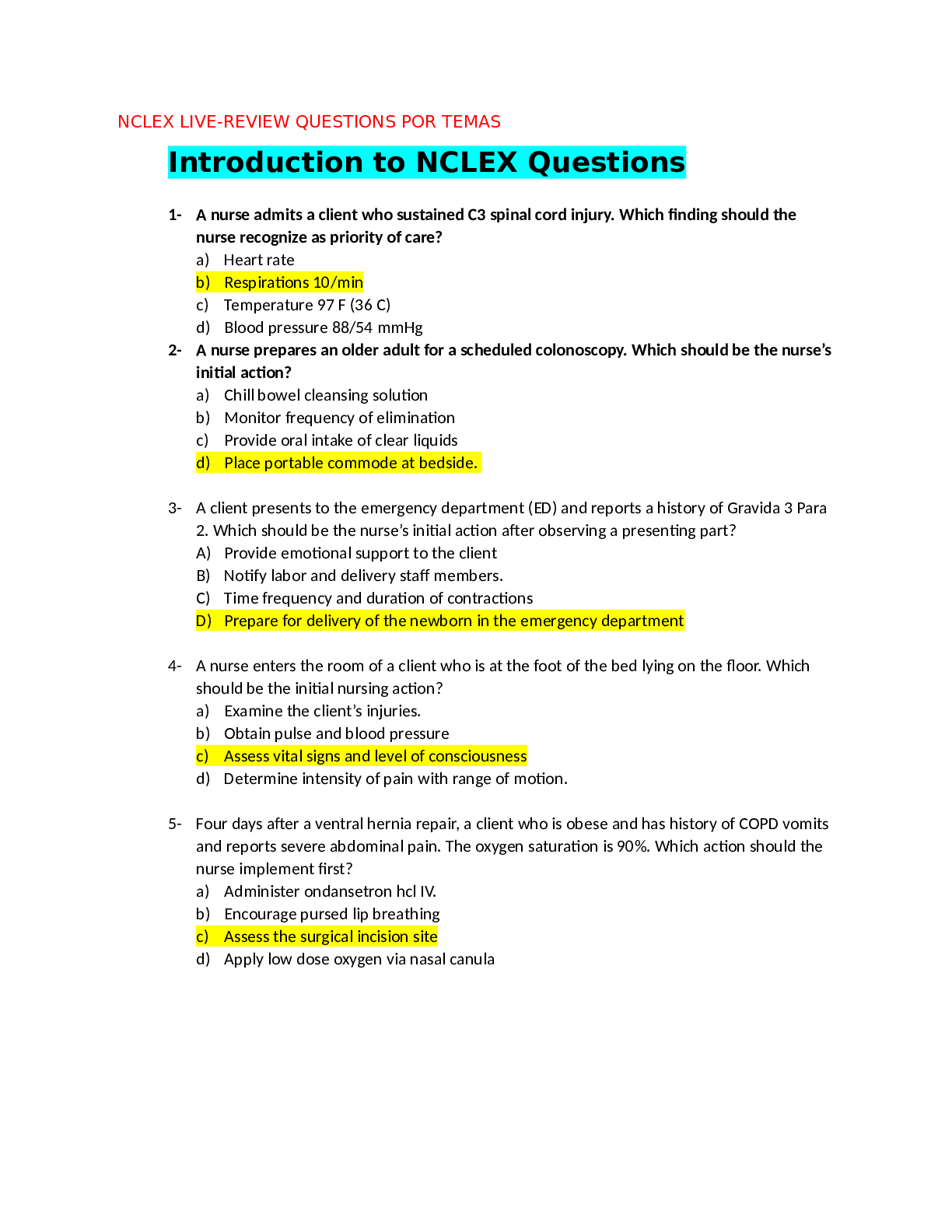
Reviews( 0 )
Document information
Connected school, study & course
About the document
Uploaded On
Mar 18, 2021
Number of pages
147
Written in
Additional information
This document has been written for:
Uploaded
Mar 18, 2021
Downloads
0
Views
75




 11e Madura test bank.png)


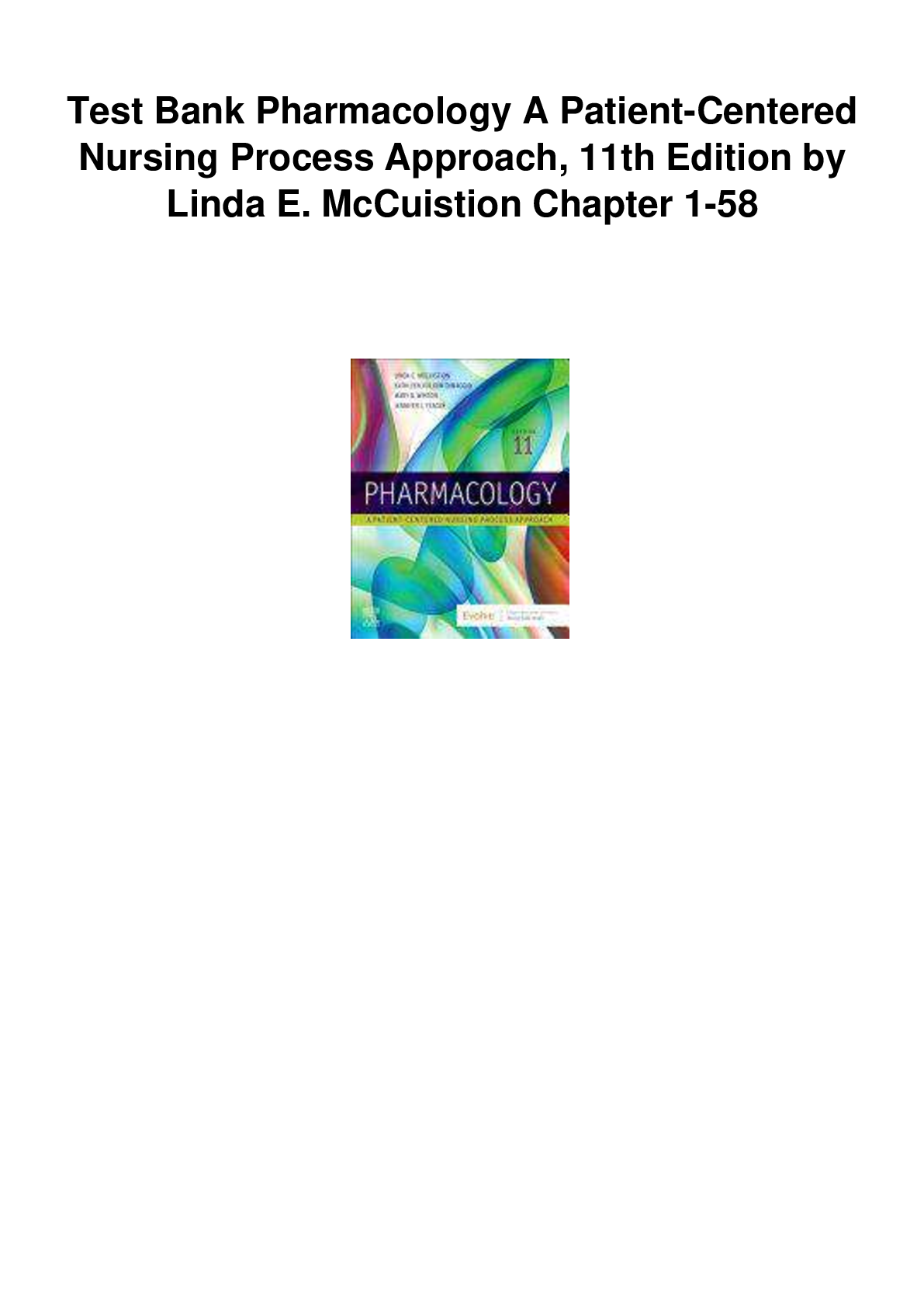
 Edition.png)
